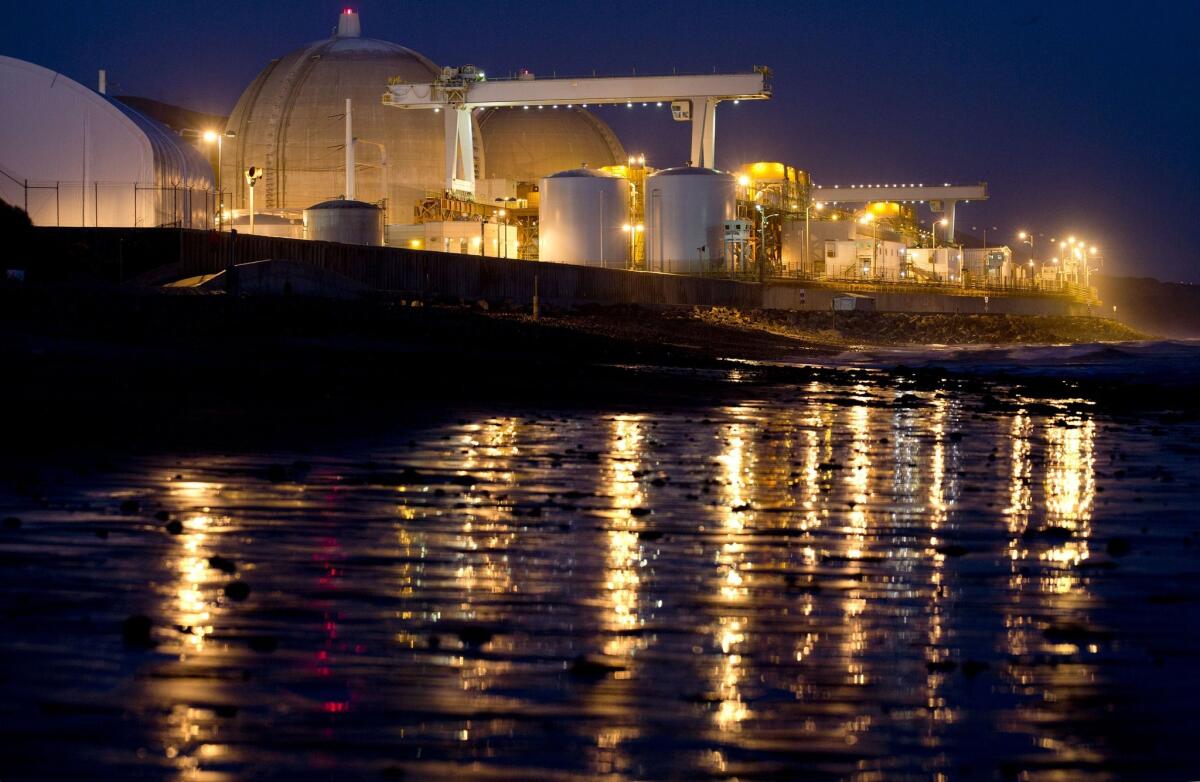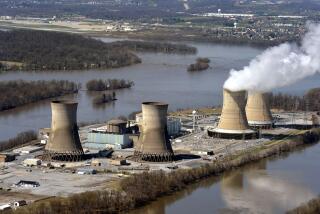Op-Ed: Nuclear power must be a part of greener future

The now defunct San Onofre nuclear power plant is seen along the Pacific Ocean coastline in San Onofre in 2012.
- Share via
Climate scientists want the world to use more nuclear energy to help reduce carbon dioxide emissions, yet America’s nuclear sector is withering. Unless Congress acts to encourage next-generation nuclear technology, the United States will be relegated to second-tier status when it comes to the development and deployment of smaller, cheaper, safer reactors that could play a crucial role in low-carbon electricity production all over the world.
The latest example of America’s declining nuclear capacity came this month when Entergy Corp. announced it would close its 838-megawatt James A. FitzPatrick Nuclear Power Plant in Oswego, N.Y., by early 2017. Just three weeks earlier, Entergy had announced the closure of its 688-megawatt Pilgrim Nuclear Power Station, in Plymouth, Mass., by 2019.
By incubating advanced-nuclear technology, the U.S. can make a lasting contribution to [combating climate change].
In all, about 10% of America’s domestic nuclear fleet could be shuttered over the next few years. The challenges facing the fleet include age (the average reactor is about 34 years old), pricing pressure due to low-cost gas-fired energy generation and subsidized renewables, and required, costly post-Fukushima safety upgrades.
It doesn’t have to be this way. Third Way, a Washington-based think tank, estimates that about four dozen companies backed by about $1.3 billion in private capital are developing plans for innovative new reactors. They include Transatomic Power (backed by Silicon Valley venture capitalist Ray Rothrock), TerraPower (backed by Microsoft founder Bill Gates) and UPower, a Boston start-up that aims to build a reactor capable of producing 10 megawatts of electricity and can fit inside a pair of 40-foot shipping containers.
These companies need a way to develop and accurately test aspects of their designs. That’s where Congress comes in.
The Department of Energy has several national laboratories — including Idaho, Los Alamos and Oak Ridge — that could provide a venue for such testing. For that to happen, Congress must give the DOE authority to oversee that testing and provide some funding. The goal, said one Capitol Hill staffer working on the issue, is to “allow the market to function.” Until the private-sector designs can be tested, the Nuclear Regulatory Commission won’t let them go into commercial operation.
A renewed focus on nuclear energy is timely given that this month, the 2015 U.N. Climate Change Conference will convene in Paris to discuss ways to reduce global carbon dioxide emissions.
Nuclear energy’s importance in reducing emissions is beyond dispute. In January, the International Energy Agency called nuclear power “a critical element in limiting greenhouse gas emissions.” It calculated that global nuclear generation capacity must more than double by 2050 (to about 750 gigawatts) if there is any hope of limiting temperature increases to the 2 degrees that is widely agreed as acceptable.
In 2013, four of the world’s leading climate scientists signed an open letter in which they said that renewable energy sources like wind and solar “cannot scale up fast enough to deliver cheap and reliable power at the scale the global economy requires.” The authors — former NASA climatologist James Hansen, Kerry Emanuel of the Massachusetts Institute of Technology, Tom Wigley of the University of Adelaide in Australia, and Ken Caldeira of the Carnegie Institution — wrote that “there is no credible path to climate stabilization that does not include a substantial role for nuclear power.”
Congress is making some progress. In May, the House passed a bill sponsored by Rep. Randy Hultgren (R-Ill.) that directs the Department of Energy to assess its ability to help test and develop next-generation reactors. Next week, the Nuclear Energy Innovation Capabilities Act will be introduced in the House by two Republicans and a Democrat, all from Texas, directing the DOE to actively partner with private companies to test and even build prototype reactors at the national labs.
Nuclear energy faces many hurdles, including the high cost of building new reactors and the thorny problem of long-term waste disposal. But the U.S. has been leading the Nuclear Age since the Manhattan Project. It should continue to lead.
Robert Bryce is a senior fellow at the Manhattan Institute. This piece is adapted from his recent report “Reactors Unplugged: Can the Decline of America’s Nuclear Sector Be Stopped?”
Follow the Opinion section on Twitter @latimesopinion and Facebook
More to Read
A cure for the common opinion
Get thought-provoking perspectives with our weekly newsletter.
You may occasionally receive promotional content from the Los Angeles Times.










